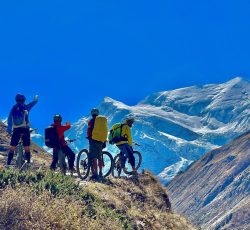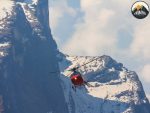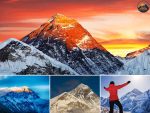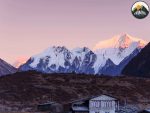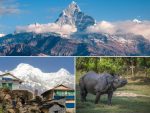If you’re planning a vacation to the Himalayas and want to know when the optimum season to trek is, the answer is “it depends”! In general, there is no optimal time for everyone. Your Himalayan adventure will be determined by how you feel about crowds, how high you intend to hike, and your tolerance for heat, cold, and rain. Each Himalaya season offers advantages and disadvantages. With this handy advice, you should be able to determine the ideal trekking season for YOU, allowing you to make
TREKKING IN NEPAL IN SPRING (MARCHA-MAY)
If you like milder weather, flowering flora, and moderate days, spring is the best time to hike in Nepal. Early spring is a tad cool, with temperate temperatures in the low elevation zones between 800-2,000m (2,600-6,600ft), making trekking in lower Annapurna reasonably enjoyable. As winter passes and spring arrives, temperatures in places with elevations above 4,000m (13,000ft) are moderate, allowing for bright, clear, and mild trekking conditions—the most of your journey.
Spring is regarded as one of the greatest seasons for trekking and climbing in the Himalayas, singing the sun and milder temperature and fields and flowering flora such as the famed giant rhododendrons giving the landscape a brilliant and bright texture.
THE BENEFITS OF SPRING TREKKING
Temperatures in the higher and lower mountain ranges range from 16 to 23 degrees Celsius (61 to 73 degrees Fahrenheit).
Daytime hiking conditions are pleasant and mild, with warmer evenings.
Snow that accumulates throughout the winter melts away by April, allowing access to high mountain passes above 5000m (16,400ft), such as Cho La, Larkya La, and Thorung La.
Clear skies early in the spring mean fewer aircraft cancellations into mountainous areas such as Lukla.
Few there are fewer treks there in October and November, which offers more opportunities to Himalayas Himalayas ‘isolated nooks.
In Nepal, spring is Everest climbing season, making it an ideal time to hike to Everest base camp.
Pros and cons of spring trekking
As summer approaches, walking at a lower altitude might become hot and humid.
Afternoon clouds are prevalent (primarily clear evenings and mornings), bringing clouds and short downpours.
SPRING TREKS RECOMMENDED
See rhododendrons in full bloom and book on the Ultimate Annapurna Dhaulagiri trek in March and April.
Book a trip to Everest Base Camp and Kala Pattar for warm weather and spectacular hiking conditions!
NEPAL TREKKING IN THE SUMMER (JUNE-AUGUST)
Summer in Nepal often brings monsoon rains from late May to mid-September. Therefore, ng during this season is not typically suggested. The monsoon brings high temperatures, heavy rain, and unpleasant circumstances. Mountainous regions are usually shrouded in clouds, while lower approaches are muddy and infested with many leaches.
However, this does not exclude you from seeing the splendour of the Himalayas from June to August! This is the best time to hike in the Indian Himalayas, and Ladakh is wonderful. Ladakh, high on the Tibetan plateau and protected from the monsoon, has a mainly dry environment during the summer months, with a clear sky, unbroken vistas, and breathtaking landscape.
THE BENEFITS OF SUMMER TREKKING
Perfect weather in the Indian Himalayas, shielded from the monsoon. Opportunities to immerse oneself in Tibetan culture and the breathtaking backdrop of the Himalayas.
Ladakh’s villages and routes see significantly fewer trekkers than Nepal’s, allowing you to appreciate the beauty and quiet of the Himalayas without the crowd.
PROS AND CONS OF SUMMER TREKKING
It is not a good time to go trekking in Nepal. The monsoon causes damp and humid weather, obstructed views, and muddy pathways.
Recommended summer treks:
Take a summer vacation in the Indian Himalayas and explore the secluded and stunningly beautiful places of Ladakh.
TREKKING IN NEPAL IS AUTUMN (SEPTEMBER-NOVEMBER)
Autumn is often regarded as the most incredible hiking season in Nepal, with beautiful sky, mild days, and excellent trekking conditions. The monsoon clears the atmosphere of dust and pollutants, allowing for crystal clean vistas and spectacular panoramas of the Himalayan mountain ranges. The most excellent, most fabulous season to hike begins about mid-September, depending on the strength of the monsoon. After the weather has settled, most days include the brilliant blue sky and intense sun that lasts all day, unlike in the spring, when a cloud comes up in the afternoon. The evenings begin to chill off rapidly in December, especially at higher elevations, necessitating thick hiking gear and a sleeping bag.
THE BENEFITS OF AUTUMN TREKKING
Even though the days are becoming warmer, the evenings are getting colder as winter approaches.
The weather is calm and bright, with beautiful skies and breathtaking vistas.
The temperature in the higher and lower mountains ranges between 15 and 24 degrees Celsius (59 and 75 degrees Fahrenheit).
CONS FOR AUTUMN TREKKING
In general, better weather attracts more visitors ad is tially valid for fall trekking in Nepal.
RECOMMENDED TREKS IN AUTUMN:
Experience the best that the Annapurna region has to offer on the Annapurna Circuit trek.
NEPAL TREKKING IN THE WINTER (DECEMBER-FEBRUARY)
Most people find it too cold to travel to high altitude locations in Nepal during the winter; daytime temperatures can vary from 9-12oC (48-54oF), and overnight temperatures can plummet to sub-zero. If the cold doesn’t bother you, it’s a fantastic season to trek to more popular areas, such as the Everest region, because there are significantly fewer people around compared to October and November and lower to mid-altitude paths, the temperature remains rather lovely. For this reason, our Christmas and New Year’s treks in Nepal are usually quite popular.
Mornings can be misty, but afternoons are generally bright, except for a dusting of snow in the mountains. With this in mind, high passes like as the Annapurna region’s Thorong La (5,416m/17,769ft) and the Everest region’s Kongma La (5,545m/18,192ft), Cho La (5,335m/17,503ft), and Renjo La (5,420m/17,782ft) are typically blocked from late November to March.
THE BENEFITS OF WINTER TREKKING
Because there are fewer people on the route, there are no crowds.
During the day, the sky is frequently clear and blue.
Winter is a beautiful time to visit the monasteries, and some new snow on the hills is ideal for photography.
THE CONS OF WINTER TREKKING
Due to snow cover, several of the high passes are inaccessible.
Colder weather necessitates more planning and preparation, but the benefits are well worth it.
RECOMMENDED WINTER TREKS:
On the Annapurna Trek, explore the lower sections of the Annapurna range for magnificent vistas of the Annapurna range and pleasant walking conditions.
